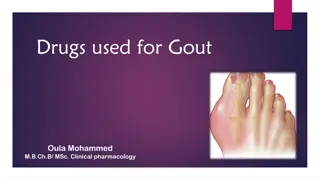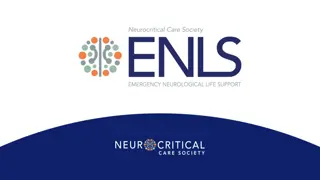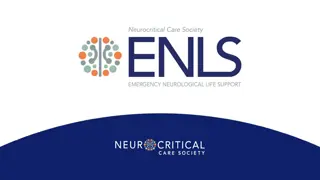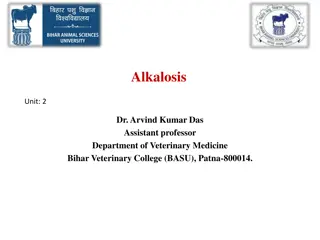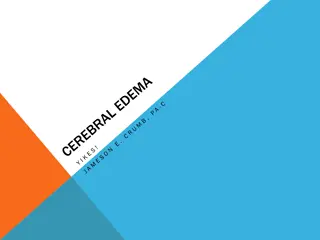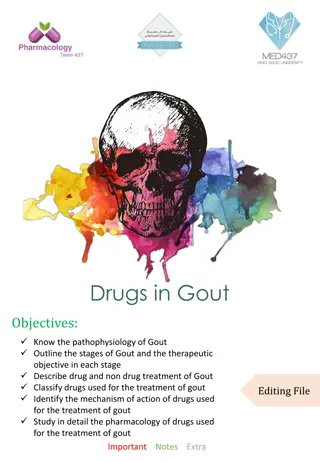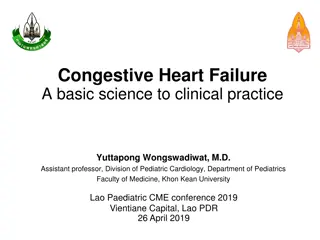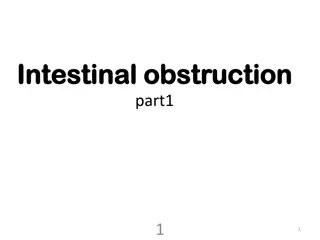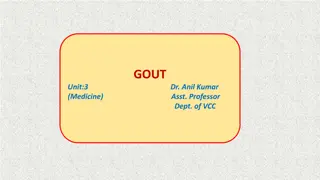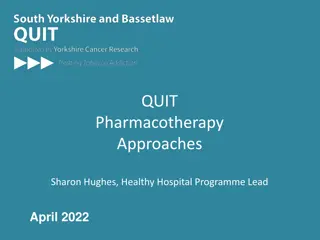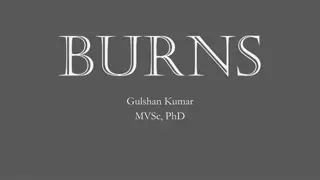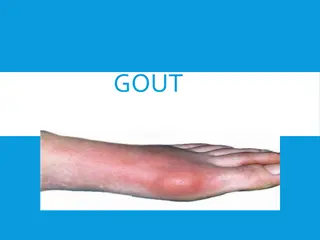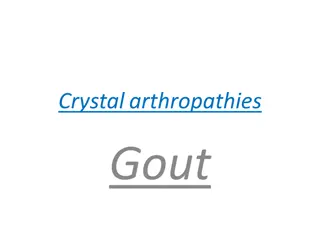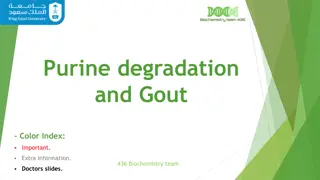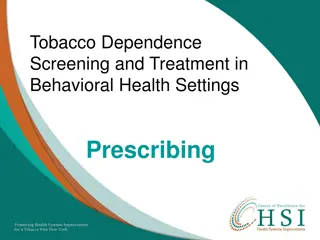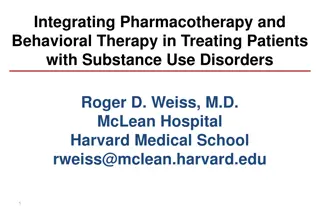Understanding Gout: Pathophysiology and Pharmacotherapy Overview
Gout is a condition caused by the accumulation of urate crystals, leading to inflammation and various symptoms like acute arthritis and joint destruction. This article delves into the pathophysiology of gout, highlighting factors like hyperuricemia and crystal formation. It also discusses pharmacotherapy options for managing gout, including drugs that affect uric acid levels and inflammation. Understanding the underlying mechanisms of gout can help in effective treatment and symptom control.
Download Presentation

Please find below an Image/Link to download the presentation.
The content on the website is provided AS IS for your information and personal use only. It may not be sold, licensed, or shared on other websites without obtaining consent from the author. Download presentation by click this link. If you encounter any issues during the download, it is possible that the publisher has removed the file from their server.
E N D
Presentation Transcript
PHARMACOTHERAPY OF PHARMACOTHERAPY OF GOUT PROF. SANJAY KHATTRI 1
GOUT GOUT Gout results from the precipitation of urate crystals in the tissues and the subsequent inflammatory response. Acute gout usually causes an painful distal arthritis, but it also can cause joint destruction, subcutaneous deposits (tophi), and renal calculi and damage. The pathophysiology of gout is understood incompletely. Hyperuricemia, while a prerequisite, does not inevitably lead to gout. 2
GOUT GOUT Contd Contd Uric acid, the end product of purine metabolism, is relatively insoluble compared to its hypoxanthine and xanthine precursors, and normal serum urate levels (5 mg/dL, or 0.3 mM) approach the limit of solubility. In most patients with gout, hyperuricemia arises from underexcretion rather than overproduction of urate. Mutations of one of the renal urate transporters, URAT-1, are associated with hypouricemia. The uricosuric effect of benzbromarone and probenecid can be explained by inhibition of this transporter. 3
GOUT GOUT Contd Contd Urate tends to crystallize as monosodium urate in colder or more acidic conditions. Monosodium urate crystals activate monocytes/macrophages via the toll-like receptor pathway mounting an innate immune response. This results in the secretion of cytokines, including IL-1 and TNF- endothelial activation; and attraction of neutrophils to the site of inflammation . Neutrophils secrete inflammatory mediators that lower the local pH and lead to further urate precipitation. 4
Synoviocytes phagocytose urate crystals and then secrete inflammatory mediators, which attract and activate polymorphonuclear leukocytes (PMN) and mononuclear phagocytes (MNP) (macrophages). Drugs active in gout inhibit crystal phagocytosis and polymorphonuclear leukocyte and macrophage release of inflammatory mediators. PG, prostaglandin; IL-1, interleukin-1; LTB4, leukotriene B4. 5
Drugs Capable of Inducing Hyperuricemia and Gout: Diuretics Ethanol Ethambutol Nicotinic acid Pyrazinamide Cytotoxic drugs Salicylates (<2 g/day) Levodopa Cyclosporine 6
Signs and Symptoms Signs and Symptoms Acute attack: Acute arthritis The metatarsophalangeal joint of the first toe often involved Nocturnal excruciating pain, swelling, redness and tenderness Chronic: Nonsymmetric synovitis Chronic gouty arthritis Periarticular tophaceous deposits 7
The aims of treatment are to: Decrease the symptoms of an acute attack Decrease the risk of recurrent attacks Lower serum urate levels 1. 2. 3. The substances available for these purposes are: Drugs that relieve inflammation and pain (NSAIDS, colchicine, glucocorticoids,) Drugs that prevent inflammatory responses to crystals (colchicine, NSAIDS and Interleukin-1 inhibitors) Drugs that act by inhibition of urate formation (allopurinol, febuxostat) or to augment urate excretion (probenecid) Converts uric acid to allantoin, which is then excreted (Pegloticase and rasburicase ) 1. 2. 3. 4. 8
Treatment of acute gout Treatment of acute gout Acute gouty attacks can result from a number of conditions, including excessive alcohol consumption, a diet rich in purines, or kidney disease. The mainstay of treatment during an acute attack is the administration of anti-inflammatory drugs such as NSAIDs, colchicine or glucocorticoids. NSAIDs are used most often in individuals without complicating comorbid conditions. The most effective drugs are indomethacin, naproxen, ibuprofen, diclofenac and celecoxib. 10
Treatment of acute gout Treatment of acute gout Acute gouty attacks can result from a number of conditions, including excessive alcohol consumption, a diet rich in purines, or kidney disease. Glucocorticoids is given i.m. or orally (prednisone). For a single joint or a few involved joints, intraarticular triamcinolone acetonide or methyl prednisolone have been effective and well tolerated. Note: Aspirin is contraindicated, because it competes with uric acid for the organic acid secretion mechanism in the proximal tubule of the kidney. 11
Chronic gout can be caused by Chronic gout can be caused by Genetic defect, such as one resulting in an increase in the rate of purine synthesis. Renal deficiency Excessive production of uric acid associated with cancer chemotherapy. 12
Treatment of chronic gout Treatment of chronic gout Treatment strategies for chronic gout include the use of uricosuric drugs that increase the excretion of uric acid, thereby reducing its concentration in plasma, and the use of allopurinol, which is a selective inhibitor of the terminal steps in the biosynthesis of uric acid. Uricosuric agents are first-line agents for patients with gout associated with reduced urinary excretion of uric acid. Allopurinol is preferred in patients with excessive uric acid synthesis, with previous histories of uric acid stones, or with renal insufficiency. 13
Colchicine Colchicine Colchicine a plant alkaloid, has been used for the treatment of acute gouty attacks as well as chronic gout. It is neither a uricosuric nor an analgesic agent, although it relieves pain in acute attacks of gout. Colchicine does not prevent the progression of gout to acute gouty arthritis, but it does have a suppressive, prophylactic effect that reduces the frequency of acute attacks and relieves pain. NSAIDs have largely replaced colchicine in the treatment of acute gouty attacks. 15
Colchicine Colchicine contd contd Colchicine is currently used for prophylaxis of recurrent attacks and will prevent attacks in more than 80 percent of patients. Pharmacokinetics: Colchicine is administered orally, followed by rapid absorption from the GI tract. Colchicine is recycled in the bile and is excreted unchanged in the feces or urine. Use should be avoided in patients with a creatinine clearance of less than 50 mL/min. 16
Colchicine modulates multiple pro- and antiinflammatory pathways associated with gouty arthritis. Colchicine prevents microtubule assembly and thereby disrupts inflammasome activation, microtubule-based inflammatory cell chemotaxis, generation of leukotrienes and cytokines, and phagocytosis. 17
Colchicine Colchicine contd contd Adverse effects: Nausea Vomiting Abdominal pain Diarrhoea Chronic administration may lead to:- myopathy, neutropenia, aplastic anaemia and alopecia. The drug should not be used in pregnancy, and it should be used with caution in patients with hepatic, renal, or cardiovascular disease. The fatal dose has been reported as low as 7 to 10 mg. 18
Uricosuric Uricosuric agents most is then reabsorbed in the proximal tubule while a small amount is secreted into the tubule by the anion-secreting mechanism. agents In humans, uric acid passes freely into the glomerular filtrate, and The net result is excretion of approximately 8 12% of filtered urate. The secretory mechanism is generally inhibited by low doses of drugs that affect uric acid transport, whereas higher doses are needed to block reabsorption. Such drugs therefore tend to cause retention of uric acid at low doses, while promoting its excretion at higher doses. 19
Uricosuric Uricosuric agents agents contd contd Both probenecid and sulfinpyrazone inhibit the secretion as well as the reabsorption of urate and, if given in subtherapeutic doses, can actually increase plasma urate concentrations. The maintenance of adequate urine flow and alkalinization of the urine during the first several days of uricosuric therapy further diminish the possibility of uric acid stone formation. Note- In addition, probenecid can inhibit the tubular secretion of other organic acids; thus, increased plasma concentrations of penicillins, cephalosporins, sulfonamides, and indomethacin can occur. 20
Uricosuric Uricosuric agents Adverse effects: agents contd Contraindication: contd Gastrointestinal irritation Allergic to uricosuric drugs Rash and hypersensitivity In patients with impaired renal function (a creatinine Precipitation of acute gouty arthritis Clearance <50 ml/min) Stone formation. Of the two agents, probenecid is the most frequently used uricosuric as sulfinpyrazone is associated with more severe adverse effects. A history of renal calculi In patients who are overproducers of uric acid For such patients, allopurinol should be used. 21
Allopurinol Allopurinol Allopurinol inhibits xanthine oxidase and prevents the synthesis of urate from hypoxanthine and xanthine. It is used to treat hyperuricemia in patients with gout and to prevent it in those with hematological malignancies about to undergo chemotherapy (acute tumor lysis syndrome). Even though underexcretion rather than overproduction is the underlying defect in most gout patients, allopurinol remains effective therapy. 22
Allopurinol Allopurinol Drug Interactions: (a) Allopurinol inhibits the degradation of 6- mercaptopurine and azathioprine: their doses should be reduced to 1/3rd, but not that of thioguanine, because it follows a different metabolic path(S-methylation). (b) Probenecid given with allopurinol has complex interaction; while probenecid shortens t1/2 of alloxanthine, allopurinol prolongs t1/2 of probenecid. (c) Allopurinol can potentiate warfarin and theophylline by inhibiting their metabolism. (d) A higher incidence of skin rashes has been reported when ampicillin is given to patients on allopurinol. 24
Allopurinol Allopurinol Contd Contd Therapeutic Uses: Allopurinol is available for oral use and provides effective therapy for the primary hyperuricemia of gout and the hyperuricemia secondary to polycythemia vera, myeloid metaplasia, other blood dyscrasias, or acute tumor lysis syndrome. In the management of gout, it is customary to antecede allopurinol therapy with colchicine and to avoid starting allopurinol during an acute attack of gouty arthritis. Fluid intake should be sufficient to maintain daily urinary volume of more than 2 liters; slightly alkaline urine is preferred. 25
Allopurinol Allopurinol Contd Contd Adverse Effects: Allopurinol is tolerated well by most patients. The most common adverse effects are hypersensitivity reactions that may occur after months or years of medication. Cutaneous reaction: Predominantly, a pruritic, erythematous, or maculopapular eruption. Occasionally, the lesion is urticarial or purpuric. Rarely, toxic epidermal necrolysis or Stevens-Johnson syndrome (SJS) occurs, which can be fatal. The risk for SJS is limited primarily to the first 2 months of treatment. 26 Fever, malaise, and myalgias also may occur.
Febuxostat Febuxostat Febuxostat is a non-purine-selective inhibitor of xanthine oxidase. It works by non-competitively blocking the molybdenum pterin center which is the active site on xanthine oxidase. It is used in the treatment of chronic gout and hyperuricemia. Side effects-nausea, diarrhea, arthralgia, headache, increased hepatic serum enzyme levels and rash. 27
Drugs Increasing Metabolism Drugs Increasing Metabolism Urate oxidase (uricase) metabolizes insoluble uric acid to soluble allantoin in the birds. This enzyme is absent in humans. Recombinant urate oxidase is now available as rasburicase. Pegloticase is another similiar drug that is pegylated to increase duration of action. Pegloticase and rasburicase are administered by i.v. route and are indicated only in patients with chronic gout refractory to other treatments. 28
Interleukin Interleukin- -1 inhibitors 1 inhibitors Drugs targeting the IL-1 pathway, such as anakinra, canakinumab, and rilonacept, are used for the treatment of gout. These agents may provide a promising treatment option for acute gout in patients with contraindications to, or who are refractory to, traditional therapies like NSAIDs or colchicine. A recent study suggests that canakinumab, a fully human anti- IL- 1 monoclonal antibody, can provide rapid and sustained pain relief at a dose of 150 mg subcutaneously 29
THANK YOU 30


